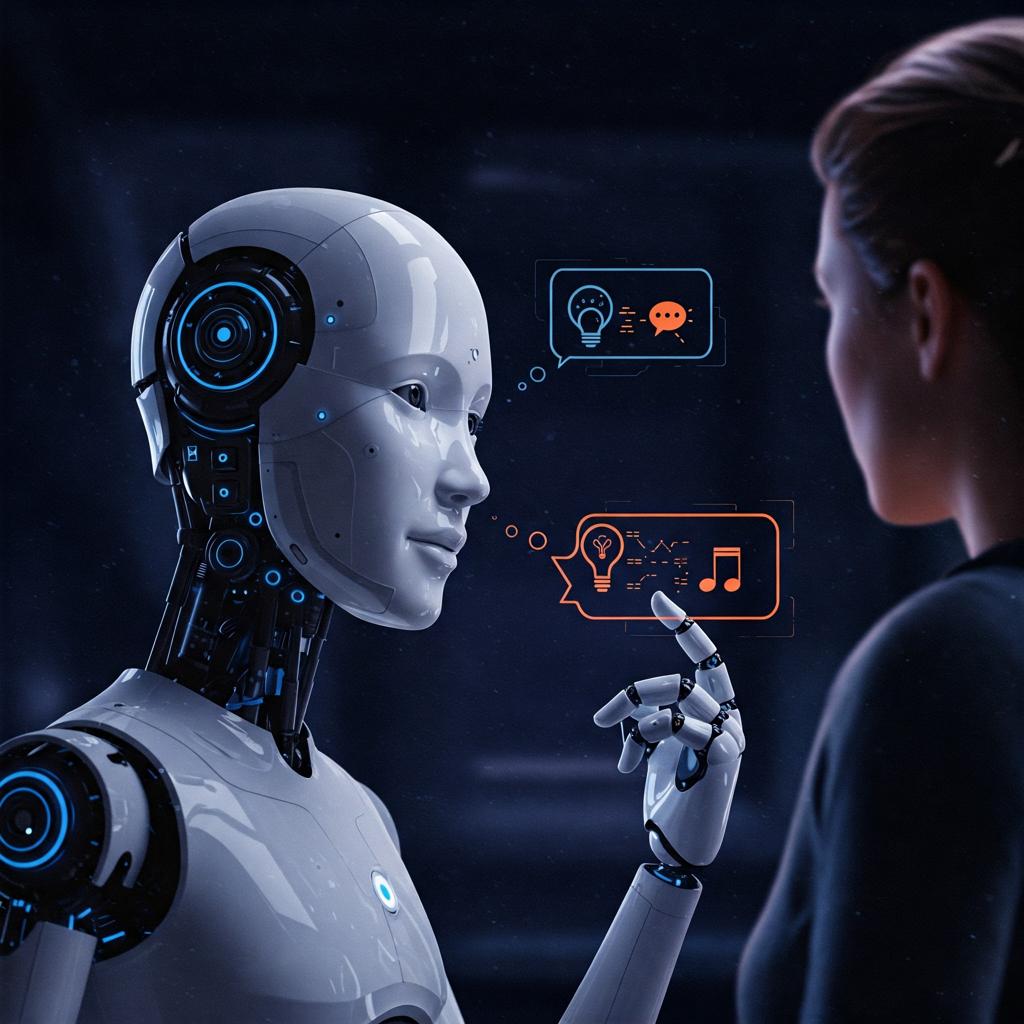
Theory of Mind AI: Simulating Mental States
Artificial intelligence has made an unprecedented leap in recent decades, evolving from simple computer programmes to sophisticated algorithms that learn, reason and even create new materials. In this context of rapid technological progress, a new and intriguing frontier is emerging: artificial intelligence with theory of mind. This is a qualitative leap far beyond current AI, derived directly from human cognitive psychology.
The psychological basis of theory of mind
Human theory of mind is the innate ability to ascribe mental states such as beliefs, desires, intentions, feelings and knowledge to oneself and others and to understand that other humans possess mental states different from one's own. It is a rudimentary cognitive capacity that emerges during early childhood and builds the basis for cognitive growth.
Thanks to the Theory of Mind, humans are able to navigate complex social worlds, predict the actions of others, communicate effectively through the ability to read subtext, sarcasm and metaphorical speech, be understanding and collaborate on projects. It is the cognitive process that allows us to perceive others not as inanimate objects that pass us by, but as entities that share their intentions and have a rich inner life.
The ambitious goal of AI with Theory of Mind is to give artificial systems the same capability, so that they can not only understand patterns of data, but also the thoughts, feelings and motivations behind human behaviour. This is a radical change from AI systems based largely on correlation analysis and rule-based reasoning, to machines capable of inferring the “why” of actions and expressions.
Distinctive features of AI with Theory of Mind
Artificial intelligence technologies created according to the principles of the Theory of Mind attempt to reproduce some of these complex human social-cognitive capabilities. This is made possible by a number of distinct features that make AI with Theory of Mind different from other artificial intelligences.
The inference of mental states is the most significant feature. Such an AI system, if equipped with Theory of Mind, should possess a computation aimed at inferring the probable mental states of human users or other agents with whom it is communicating. These include recognition of emotional expressions, interpretation of subtle linguistic and phonetic indicators of meaning, recognition of explicitly expressed or implicitly conveyed beliefs, and recognition of intentions and desires. This is more than mere classification and involves the construction of a dynamic internal simulation of the other agent's mind.
Another essential feature is empathic responsiveness. Starting from inference about mental states, particularly emotions, AI with Theory of Mind aims to provide empathic responses. It is not just a matter of observing that a person is sad, but of responding in a way that recognises and reacts appropriately to sadness. True empathy in AI is not about the AI “feeling” the sentiment, but rather about the AI understanding the effect the sentiment has on the human individual and applying that knowledge to modify its own behaviour in a way that is helpful rather than harmful.
By imitating the thoughts of others, AI with Theory of Mind could greatly improve its ability to predict behaviour and make decisions in social contexts. In a negotiation environment, an AI could anticipate a counterpart's response to an offer based on its purpose and inferred beliefs. In autonomous vehicle driving, a car equipped with Theory of Mind would be able to more accurately predict the actions of pedestrians or other drivers, inferring their purpose from small clues rather than from trajectory data alone.
Human communication is full of subtext, implication, humour, sarcasm and indirect requests, all of which are not always present in the Theory of Mind AIs we often see. The artificial intelligence in Theory of Mind aims to accept the richness, that a request to pass the salt is not a question of skill but an invitation. It can perhaps distinguish between rhetorical and real questions, or understand when the literal meaning of an utterance is not the one conveyed by the context based on what it has learnt about the speaker's thinking.
Potential uses and research areas
Although Theory of Mind AI has not yet been fully created, it is being researched by many researchers for its principles in numerous areas. Its potential applications are vast and revolutionary.
In the area of collaboration and robot-human interaction, imagine factory robots not only performing tasks in tandem with humans, but also understanding the attention, intention and potential confusion of their human collaborator. The robot could proactively offer the right equipment, adjust speed if the human seems under pressure or confused, or even signal a likely safety hazard based on the prediction of the next human action.
Virtual assistants and the future of chatbots have enormous potential. A Theory of Mind-based assistant can engage in much more complex conversations, inferring the user's anger from the failure of a serial command or his rudeness and proposing alternative solutions or another mode of interaction. He might infer the implicit demands or emotional background of a question.
Theory of Mind inference Artificial intelligence would significantly enhance medical diagnostic equipment, patient observation and treatment therapies. Artificial intelligence systems would be able to examine patient interactions to allow doctors to identify early signs of depression, anxiety or cognitive loss based on subtle emotional cues beyond literal language. Therapeutic chatbots or companion robots could improve empathic care by modifying their responses based on the patient's perceived emotional state.
As far as educational technologies are concerned, intelligent tutoring systems would prove much more effective with Theory of Mind features. An AI teacher would not only be able to check whether the answer given by a student is correct, but also infer his or her state of understanding, level of confidence, degree of frustration or boredom. Based on these deduced mental states, the system could modify the teaching strategy.
For autonomous systems, it is necessary to understand what pedestrians, cyclists and human drivers will do. A car equipped with Theory of Mind would not just observe where a pedestrian is and how fast he is going, but could infer his intent to cross the road from his head direction, gaze and posture before he steps off the kerb.
Potential benefits and significant challenges
A well-implemented development and application of artificial intelligence systems with Theory of Mind concepts can have significant advantages. Interaction would be more intuitive, natural and effective with machines that can interpret implicit signals, operate in the same affective space as humans and make good inferences about users' needs. This could lead to highly personalised experiences, effective emotional assistance and better cooperation between humans and AI.
But the road to creating true AI with Theory of Mind is riddled with formidable technical and ethical problems. The internal states of human beings are very complex, subtle, typically ambiguous and context-dependent. Moreover, humans tend to misunderstand each other. Developing algorithms that can correctly and consistently infer these internal states from external behaviour is a huge technical challenge.
The ethical problems are equally profound. Equipping machines with the ability to know and potentially act upon human mental states raises serious ethical issues of manipulation, privacy, autonomy, deception and bias. Empathic AI could be used to manipulate users on a decision-making or emotional level for political or commercial reasons. Inference of mental states involves access to potentially sensitive personal data and it is unclear how this could be done without violating users' privacy and consent.
The technical and computational obstacles are equally formidable. Developing AI with Theory of Mind requires innovations in several areas, including robust affective processing, high-level natural language understanding, high-level cognitive modelling and significant computational capacity to execute these complex models in real time.
Technical solutions and opportunities
Researchers are working on several technical directions to provide artificial intelligence with theory-of-mind-like capabilities. There are cognitive architectures that formally encode certain aspects of human cognition, deep learning and neural networks on big data of human interaction, social simulation through reinforcement learning, probabilistic modelling using Bayesian methods and hybrid methods that integrate components from different approaches.
The journey towards more sophisticated AI with Theory of Mind has already begun and will be a series of incremental advances. The expected progress will depend on the continuing advances in computer science, cognitive science, psychology and neuroscience. Priority areas of activity will include the development of more sophisticated emotion recognition and intent inference algorithms, the development of larger, more diverse and ethically sourced datasets on which to train social artificial intelligence, the development of more sophisticated testing methodologies to allow for in-depth verification of Theory of Mind capabilities, the integration of Theory of Mind modules into existing artificial intelligence capabilities, and the securing of robust ethical and regulatory frameworks.
Although the challenges are Herculean, the quest for AI with Theory of Mind continues because the benefits are enormous. This is not merely a technical issue, but a quest to redefine man and his thinking beast, at a time when technology is not a machine but a harmonised and holistic partner in the human enterprise. To embark on this exciting journey, we will have to carefully manage its course, under the direction of ethical considerations and human welfare.









